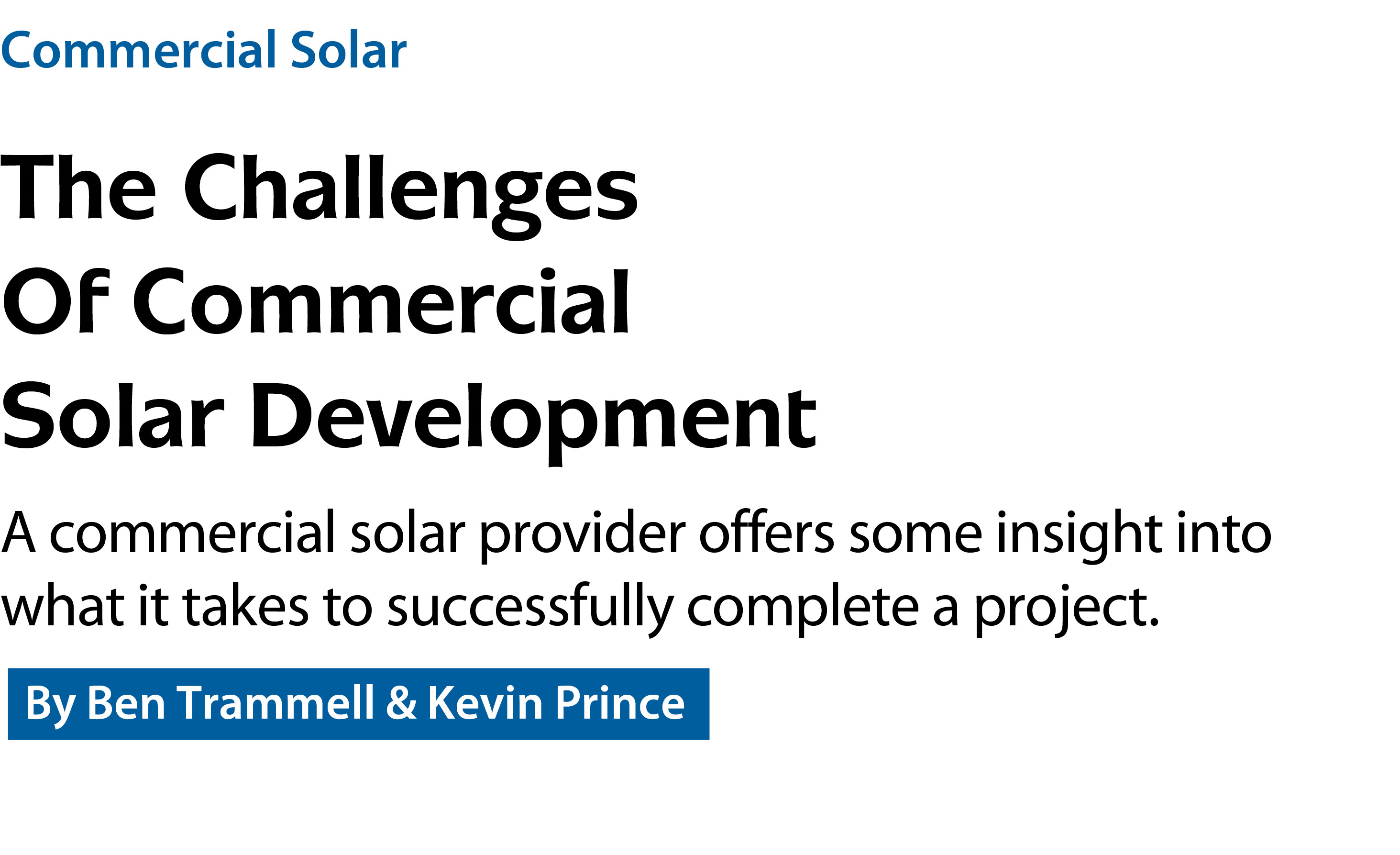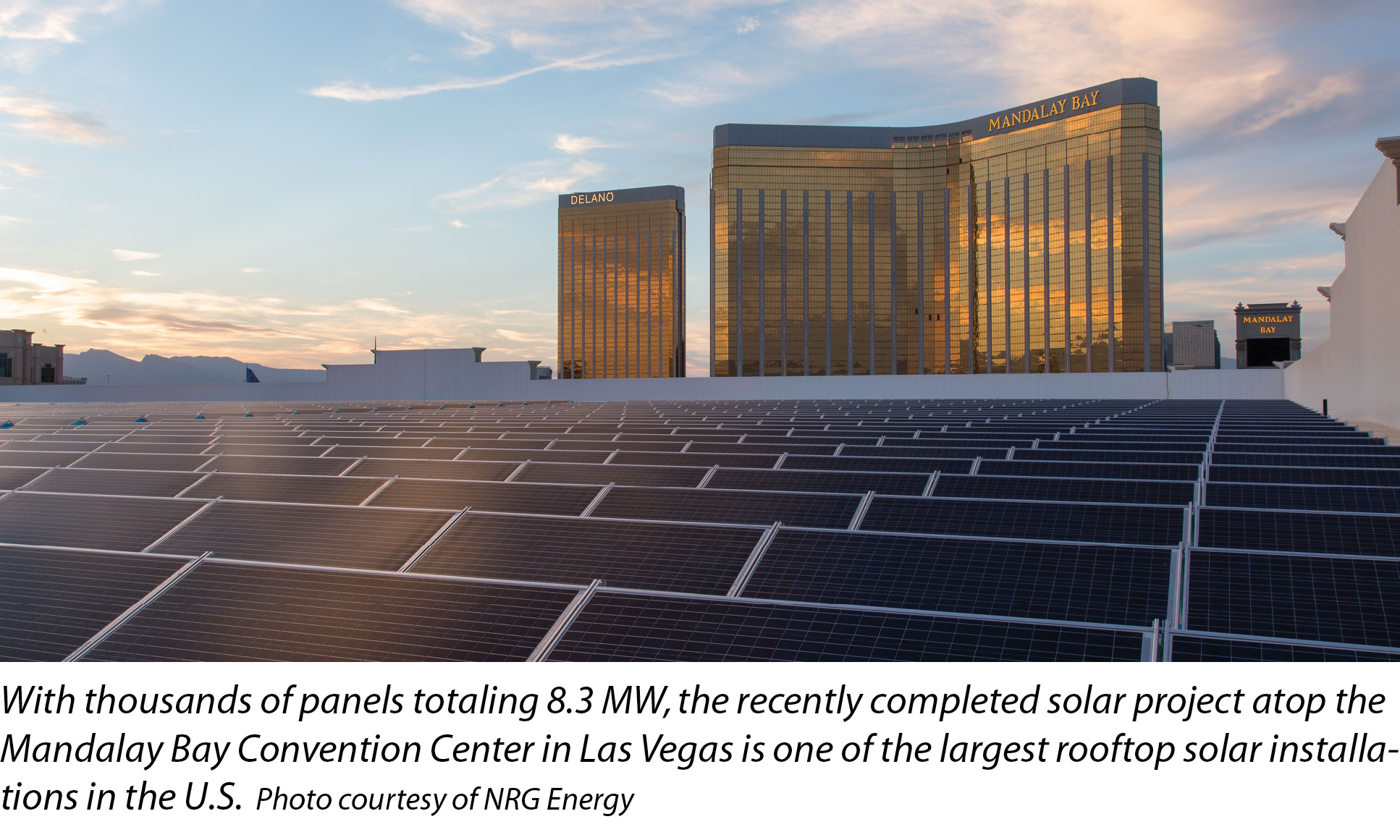

301 Moved Permanently
In the “old” days (really only about six years ago), developing, designing and building a solar photovoltaic array in the U.S. was relatively straightforward. Utility-scale solar reigned supreme, and the majority of solar projects were massive farms located in the Southwest. Here’s how it worked:
1. A solar company would locate and partner with landowners at ideal solar field sites (then, primarily in the West or Southwest);
2. It would obtain relevant permits at all levels;
3. Once pre-work was complete, an engineering, procurement and construction team would install ground-mount racking systems, attach PV panels and place a system of inverters to convert the panels’ electricity from direct current to alternating current;
4. Transmission and interconnection work would follow; and
5. The project would go online.
Naturally, the process involved much more than that, but that’s essentially how it worked.
Today, although much of that same work takes place across the U.S., solar development is evolving into the next phase, with commercial solar becoming more predominant in many areas of the country.
Solar power is growing exponentially, and the technology is moving from the U.S. desert into more populated areas as customers take a previously under-utilized asset (a rooftop or surface parking lot) and turn it into an investment opportunity that reduces operating expenses. Commercial sites are often highly active and populated and require multiple layers of coordination and execution.
Over the past three years, commercial installers have seen a new solar landscape take shape as they develop, design and build systems for customers that span the spectrum of businesses, sports facilities, nonprofit organizations and others. These locations present both challenges and opportunities for the growing solar industry.
Before even thinking about design or construction, a commercial solar provider’s team should approach potential customers and engage with them about their interest in, and how they can benefit from, installing solar energy. Companies, such as retailers and hospitals, and institutions, such as colleges, are increasingly committing to sustainability goals for renewable energy, and many want to generate the power themselves by taking advantage of ideal solar conditions at their facilities.
When considering potential sites for an installation, a commercial solar provider must assess the location’s solar potential. First: the site’s “solar resource.” How sunny is the location, and how little or how much shading is in the area? Second: the customer’s rate structure. How much is the customer paying for its energy? Third: the state’s regulatory environment. What are the policies on interconnection standards, net-metering guidelines and available state rebates?

Once establishing a partnership with a customer, a commercial solar provider begins work in earnest to start designing and constructing a project. Some key on-site challenges to address include the following:
Safety: At every work site, safety is first and foremost. Working in occupied commercial sites presents new factors to take into account, such as public and employee foot traffic. This involves top-to-bottom coordination with a facility’s in-house safety teams. Completing every project with zero injuries is always the goal.
Flexibility: It’s critical to take into account a facility’s schedule and security restrictions to allow for flexibility in the construction schedule. A phased approach to the design and construction of an array at a busy facility is often required in order to minimize site disruption. Many commercial sites also have construction taking place at the same time as a solar installation, so it’s important to coordinate.
Communications: Today’s commercial solar installations involve multiple parties - everyone from building owners, to community leaders and regulatory bodies, to neighboring businesses. Communicating effectively across the board (from the initial conceptual design throughout the system’s 25-year useful life) is paramount to a successful project.
Two of our recent projects illustrate the aforementioned challenges:
San Diego International Airport: We’ve been working with several partners to design and build a significant solar array at one of the U.S.’ busiest and growing airports. The first phase of the project included a 1.15 MW system atop the east and west portions of Terminal 2 West and a 2.16 MW carport system over the Terminal 2 West parking lot. The first phase is complete, and we recently broke ground on a second one to expand the project’s solar capacity.
Building a solar array at a major international airport can be difficult. Airports represent a major opportunity for solar energy due to their abundance of land space and full sun exposure (lack of tree coverage). With this opportunity also come issues to deal with: workforce access; materials transportation and staging; the need to work alongside federal, state and local security agencies; and the high-decibel level environment of an airport. While installing an array on the roof of an airport terminal, it is critical to tightly control the work area to prevent loose debris that may blow off the roof and onto the tarmac, potentially disabling a jet engine. We also took measures to ensure our carport solar array structures and clearances complied with the Americans with Disabilities Act - an aspect of commercial construction that we see at multiple sites. Also, in stark contrast to work at utility-scale solar projects, work at the airport has required traffic mediation and control in order to allow crane lifts above roadways.
The first-phase PV installations are expected to generate enough electricity in their first year of operation to offset up to 15% of the power demands from Terminals 1 and 2. They’ll also save up to $8 million in total energy costs over the 20-year power purchase agreement (PPA). In 2008, San Diego International adopted a formal sustainability policy, which includes a commitment to reducing greenhouse-gas emissions and achieving LEED certification in all new construction. The solar project helps the airport meet its sustainability needs.
MGM Resorts International - Mandalay Bay Resort Convention Center: We recently completed two phases of what’s now one of the largest rooftop solar arrays in the U.S. at the Mandalay Bay Resort Convention Center, located in Las Vegas. Combined, the two-phase project delivers 8.3 MW of energy.
Two major hardships quickly surfaced during the installation.
Life in Las Vegas never slows down, so the logistics of getting the sheer volume of materials and equipment onto the roof while adhering to the busy schedule of the convention center sparked quite the challenge that we worked through together with our partners.
The second hardship was the intense and relentless heat on the roof. Construction began in July, which is one of the most scorching months in the desert city. Temperatures often soar above 115˚F in this bustling metropolis. Managers on-site took pains to ensure safety was first and foremost. A few notable precautions included the following:
• To protect against heat and heat stress (both big issues on the rooftop), we provided shade canopies and cold water stations for the installation crews;
• A “buddy system” ensured the installers watched out for each other. If someone was acting out of the ordinary, he or she would get told to take a break, get cold water and cool off; and
• We also established a “glove club,” which developed small incentives to ensure hand protective gear was worn at all times - with no exceptions.
During the entire construction project, only one minor injury occurred.
In developing the second phase of the Las Vegas project, we also decided to install static reflectors designed by Ten K Solar and 3M on the backside of each wave of the array. The reflective array system, which required new training for installers, helps increase the light received and overall production at the site.
The entire 8.3 MW project took nearly two years to complete, and it generates enough electricity to power the equivalent of 1,000 homes. MGM made the strategic decision to install solar on the convention center because of the facility’s large, 20-acre, sun-oriented rooftop space. Simply put, it’s the perfect location for a solar array - drenched in abundant sunshine for the majority of the year. Through a PPA, Mandalay will buy all of the electricity generated by the 26,000+ solar panels.
Taking a look at the road ahead, as the solar industry races at the speed of light, we will likely see new challenges. We are partnering with and installing solar facilities at places such as Colby College in Maine and a Trappist monastery in Massachusetts; community solar facilities in small towns in several states; and on-site solar facilities for companies such as Kaiser Permanente and Whole Foods Market.
Partnerships, safety, flexibility and communications - these four facets (among many others) help define today’s commercial solar market. If a commercial solar provider can achieve all on any given project, it achieves success. What will the next phase of commercial solar look like? Only time will tell. But we’re looking forward to being a part of it.
Commercial Solar
The Challenges Of Commercial Solar Development
By Ben Trammell & Kevin Prince
A commercial solar provider offers some insight into what it takes to successfully complete a project.
si body si body i si body bi si body b
si depbio
- si bullets
si sh
si subhead
pullquote
si first graph
si sh no rule
si last graph